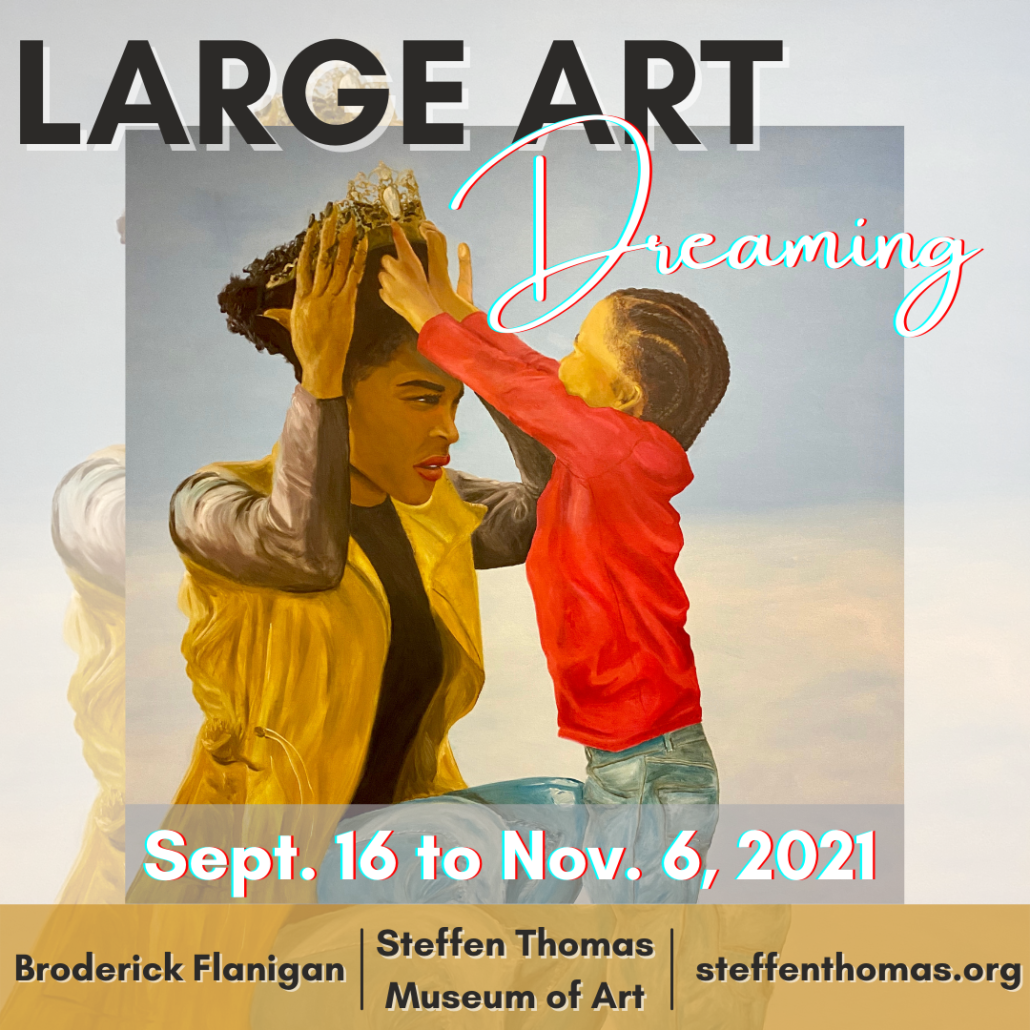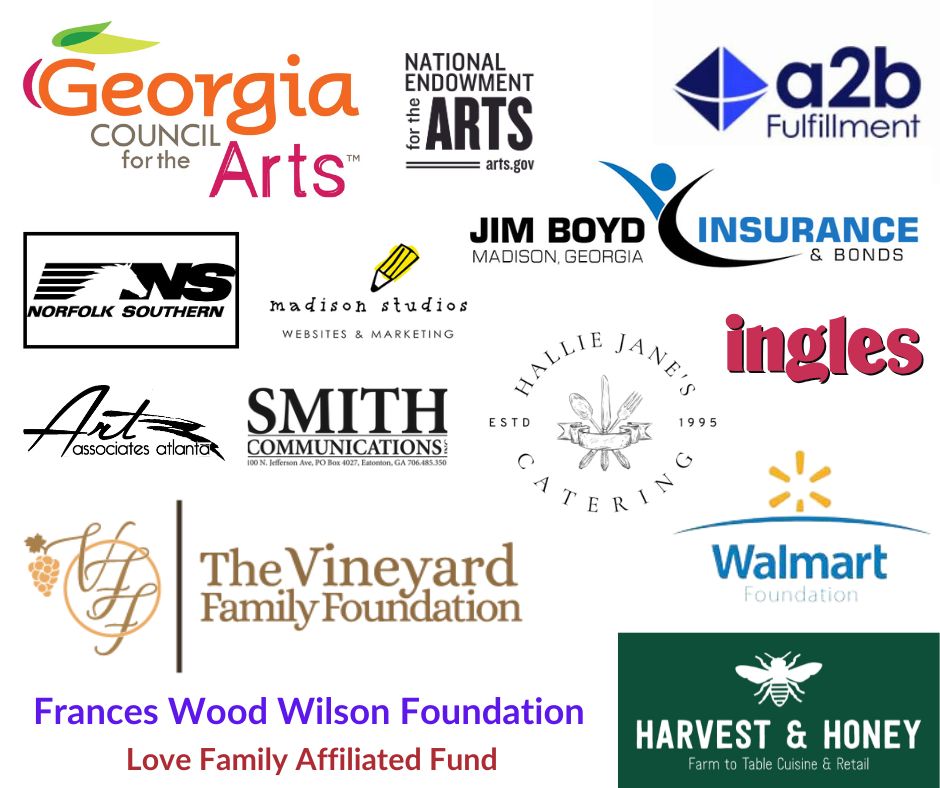Large Art Dreaming (Sept 2021- Nov 2021)
Large Art Dreaming
Sept. 16 – Nov. 6, 2021
This show is an ambitious collaboration between STMA and Athens artist Broderick Flanigan. From Sept. 16th to Nov. 6th . Museum visitors will find large scale paintings made by Clarke County Middle School students with Flanigan’s mentorship, a mural being painted *live* on the gallery wall by Flanigan and a small group of high schoolers, and a selection of Flanigan’s own paintings.
In June and July of this year, Flanigan worked with a group of middle school students from Clarke County Middle School to create the large panel paintings for this exhibition, inspired by artist Steffen Thomas’s philosophy of the Brotherhood of Mankind.
Live Mural Painting
Sept. 27 to Oct. 9, 2021 | Live streamed during select times
From Sept. 27th to Oct. 9th, visitors will be able to watch a mural being painted on the gallery wall. Flanigan and a small group of students from Clarke County High School and Morgan County High School will bring their design to life. Everyone is encouraged to watch the live stream of this, which will be available on Zoom during select days.
From 10 am to 3 pm on:
- Monday, Sept. 27th
- Wednesday, Sept. 29th
- Friday, Oct. 1st
- Monday, Oct. 4th
- Wednesday, Oct. 6th
- Friday, Oct. 8th
- Saturday, Oct. 9th
Reception and Artist’s Talk
October 16, 2021 | 3:30 – 5:30 PM
Please join us for a public reception for Large Art Dreaming on October 16th, 2021 from 3:30 to 5:30 pm. Artist Broderick Flanigan will give a talk in the West Gallery, explaining how the student panels and mural in Large Art Dreaming were created as well as his own artistic processes.
About Broderick Flanigan
Broderick Flanigan’s Website | Instagram
For artists of a certain tradition, art-making is intrinsically tied up with community-building. Athens, GA, painter and muralist Broderick Flanigan is one of those artists. Flanigan’s processes are rooted in community uplift and love, elements he brings to his works in a variety of ways. When he is commissioned to make a mural in a new city, Flanigan invites citizens to tell him about the local people and the place he is in, drawing on that dialogue as he designs his piece, and incorporating local figures and visual elements that are suggested to him by the community. The community is also integral to the making of these works — Flanigan writes his budgets to incorporate stipends to pay local student artists to help complete his murals, and when being interviewed by local press, he asks that reporters talk not only to him, but also to his young assistants.
For Flanigan, passing the mic to give others a chance to use their voices is an integral part of the practice. Flanigan’s studio practice, though more solitary, is no less rooted in community. On canvas, he uses his brightly colored style and a variety of mixed-media elements to make portraits of members of the community around his art studio, which is located near a public housing hub in a majority-Black neighborhood, with the kind of dignity and recognition that those from outside the community often fail to bring. And the art he makes about the people around him comes from a place of deep thoughtfulness about their lives and the factors that affect them.
A recent series of paintings featuring hundreds of discarded bottle caps Flanigan collected exemplifies the many ways community is expressed in his studio practice. Exploring the question of what having all these bottle caps around means for a community, and drawing on a childhood game in which he and a friend would collect bottle caps and try to find the rarest one, the series incorporates these bottle caps to depict a 16th century-style halo, the bars of a cell and a throne, while exploring themes of economic stratification, feelings of being trapped and elevating troubled neighbors with love. This, ultimately, is the thrust of Flanigan’s practice, from the privacy of his studio to the walls of far-flung cities, as well as in his work as an organizer in his day job — a place where people can be recognized and allowed to participate as their full selves. “I’m not speaking in terms of assimilation,” he says. “What can we create where people are from so that they can show up and participate as their full selves?”
Helping Art Reach Public Spaces (HARPS)
In 2015 Flanigan created an outreach initiative called HARPS (Helping Art Reach Public Spaces). A mural arts program for teens was born introducing youth to the hands-on entrepreneurial experience of the art-making process. Flanigan believes that the arts can provide cultural and economic investments that have a significant impact on low-income and under-resourced communities.
The mural project introduces students to public art and mural making through painting/drawing, techniques and concepts, with emphasis on understanding the fundamentals of artistic expression. Even though previous painting experience is not a prerequisite for this project, the projects provided an introduction to prepare students for going into a professional art career. Mural making was geared towards realism; at the same time, various other painting and drawing styles were discussed and explored. Color theory, compositional structure, figure/ground relationships, visual perception, spatial concepts, and critical thinking skills were all emphasized.
We studied and discussed various techniques. The hope was that students will use this global approach to develop a “critical eye” in the evaluation of mural making through painting and drawing. Demonstrations, videos, and lectures were given throughout the course. Acrylic paint was the primary painting medium for the project. The students were given a prompt for the mural concept discussion. The Brotherhood of man quote by Steffen Thomas and a short video about the artist sparked the dialogue.
This program is supported in part by the Georgia Council for the Arts through the appropriations of the Georgia General Assembly and the National Endowment for the Arts, the Frances Wood Wilson Foundation, and the generous donations from STMA patrons.
Thank You.




